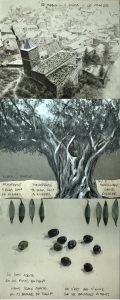
Mudejar clay
The “Mudéjar Mud” project investigates the capacities of this material from its natural state to its manufacturing process and the elaboration of pieces for use or application in architecture.
Clay is the basis of Aragonese Mudejar construction, which, through its working process to achieve brick and glazed ceramics, become identifiers of our architecture and, therefore, shapers of our identity.
Using and investigating the quarries and the process of elaboration of the material, the project aims to establish certain conclusions about the constructive possibilities of the material and the differences and similarities that it has depending on the territory in which we find ourselves.
The localities in which work was carried out during the investigation were San Mateo de Gállego, Zuera, Villamayor de Gállego, Alagón, Fuentes de Ebro, Quinto, Torralba de Ribota, Aniñón, Sabiñán, Cervera de la Cañada, Ateca, Calatayud, Maluenda, Terrer, Belmonte de Gracián, Morata de Jiloca, Villafeliche, Mainar, Villarreal de Huerva and Tobed.
The methodology used begins with the search for quarries and locations where to extract the clay and pigments with which to work for the construction and decoration of the pieces, the analysis of plasticity of the samples “in situ”, the extraction of the most plastic clays and processing, the sieving and hydration of the clay, the test of plasticity, the firing to determine its deformation and porosity, the drafting of the conclusions of the analysis and the selection of the most suitable clays for the project, the construction of the pieces, the study of the most suitable clays for the construction of the pieces, the plasticity test, the firing to determine its deformation and porosity, the drawing up of the conclusions of the analysis and the selection of the most suitable clays for the project, the construction of the pieces, the study of the technique depending on the characteristics, which can be lathe, pinch, slabs or casting on moulds.
The expected results of this research process are intended to be reflected in the creation of a series of ceramic pieces inspired by Mudejar art.
The project’s objectives were as follows:
- Use of local materials. Clays and pigments collected in the geographical area of the Mudejar territory.
- To study the Mudejar heritage, analyse its forms and the patterns used, being the basis of inspiration for the creation of ceramic pieces.
- To learn about other types of Mudejar and traditional ceramics existing in the localities.
- Identify the existence of potteries, tile kilns or brick factories close to the villages where the construction material for their buildings and the ceramic elements that make them up may have come from.
- Document testimonies of local craftsmen or people who may have worked in local potteries or tile kilns.
- Involve local people in the search for sample locations.
- Involve the local population in the activity “earth and colour walks”, so that they can learn about the process followed and the resources used.
LINE OF RESEARCH: New perspectives on Mudejar art.
AUTHOR: Javier Seral




